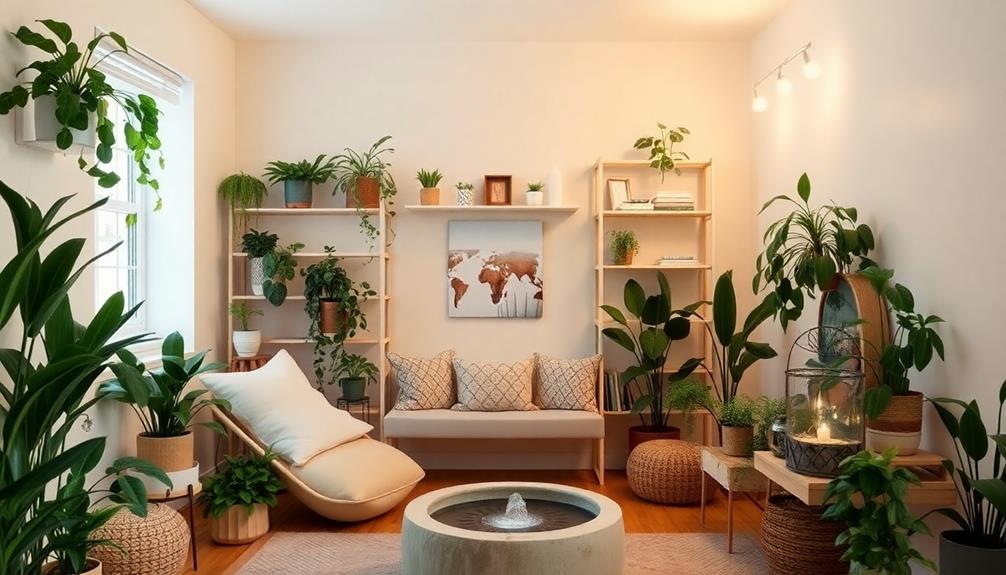Every modern home needs Indonesian textiles because they elevate your space while connecting you to vibrant cultural stories. The unique craftsmanship and natural dyeing techniques create stunning pieces that add character and warmth. These textiles serve as striking focal points, enhancing decor from bohemian to contemporary styles. Plus, by choosing Indonesian textiles, you're supporting artisan communities and promoting sustainable practices. Each piece carries a rich heritage and incorporates eco-friendly methods, helping preserve the environment. If you're curious about how to infuse your home with these beautiful cultural elements, there's so much more to explore.
Key Takeaways
- Indonesian textiles feature vibrant colors and intricate designs, making them striking focal points that enhance home aesthetics.
- Unique weaving techniques and sustainable practices promote durability and eco-friendliness, contributing positively to the environment.
- Incorporating these textiles fosters an emotional connection to cultural heritage, enriching the home with storytelling and artistry.
- Community-based initiatives empower artisans, ensuring traditional craftsmanship thrives and supporting local economies.
- The versatility of Indonesian textiles complements various design themes, adding depth and character to modern home decor.
The Art of Indonesian Weaving

Indonesian weaving is a vibrant tapestry of tradition and skill that captivates anyone who encounters it. This art form, passed down from generation to generation, showcases the rich cultural heritage of Indonesia.
As you explore the techniques, you'll notice the meticulous Morinda dyeing process, which uses natural dyes to create stunning colors that resonate with the surrounding environment, including hues inspired by the nearby garden. The intricate designs often reflect regional artistic styles, similar to the craftsmanship seen in Indonesian decor masks, highlighting the deep connection between various forms of Indonesian art.
Using back strap looms, artisans weave in comfortable settings that foster community bonding. These portable looms allow for flexibility, adapting easily to various projects and locations.
The careful alignment of warps during the ikat technique is vital, ensuring that the intricate designs maintain their integrity through the dyeing and weaving process. Heddles, essential for lifting alternate threads, can be crafted from various materials, adding versatility to each piece.
The density of warp threads greatly impacts the fabric's weight and handling, influencing both aesthetic appeal and practical use. So, when you incorporate Indonesian textiles into your home, you're not just adding beauty; you're embracing a rich legacy that celebrates craftsmanship and community.
Unique Loom Techniques

Explore the fascinating world of unique loom techniques that define Indonesian textiles. These techniques, often involving back strap looms, allow you to create portable weavings with unique tension dynamics. This not only enhances the texture of the fabric but also its durability.
The use of vibrant colors and intricate patterns, as seen in Indonesian Decorative Pillows, adds an extra layer of cultural richness to these textiles. Moving forward, you'll notice that loom configurations vary greatly, with some weavers using simple post setups while others employ more complex framed structures. This adaptability allows for two different scales of projects, catering to various artistic needs.
The creation of heddles is another essential aspect of Indonesian weaving. By facilitating the alternate lifting of threads, heddles enable you to craft intricate designs that elevate the artistic value of the finished textile.
Additionally, techniques like the circular warp method produce distinctive patterns. You can weave items one at a time, maintaining high design integrity while usually speeded by your familiarity with the process.
The Ikat Weaving Process

When it comes to creating stunning textiles, the ikat weaving process stands out with its intricate methods. You'll appreciate the meticulous alignment and securing of multiple warp threads, which is essential for maintaining the design's integrity. Each step you take in this process guarantees that the intricate patterns emerge beautifully, reflecting the rich cultural significance of textiles in traditional Indonesian housing.
Different binding methods for the warps play a significant role in the dyeing process, directly affecting the final appearance of the fabric. As you work with heddles—fundamental for lifting alternate threads—you'll find they can be crafted from various materials, allowing for flexibility in your ikat designs.
Inserting the weft yarn requires careful attention as you maneuver it into the shed created between the lifted threads. Precise tension and alignment are critical at this stage to guarantee a flawless finish.
You'll also notice the beating technique, particularly in areas like Sumba, which loosens threads and maintains fabric integrity. This method highlights the physical demands of ikat weaving, making it a true art form. By understanding this process, you can appreciate the beauty and craftsmanship that go into each piece of ikat textile.
Textiles as Cultural Identity

Indonesian textiles aren't just beautiful; they're a living expression of cultural heritage that connects you to the past.
Each pattern and motif carries deep symbolism, telling stories of ancestors and nature that shape community identity.
These textiles often feature vibrant colors and intricate designs reminiscent of traditional artistry, such as the craftsmanship seen in Indonesian Decor Masks.
Cultural Heritage Preservation
Textiles are more than just fabric; they represent the rich cultural identity and craftsmanship of Indonesia's diverse communities. When you incorporate Indonesian textiles into your home, you're not just adding beauty; you're also participating in a crucial cultural preservation effort. Each piece carries stories and traditional techniques passed down through generations, reflecting the unique social structures and spiritual beliefs of communities, like those from Balinese villages or the Atoni Lafayek of Timor.
Furthermore, these textiles, much like the intricate designs of Indonesian decor masks, often depict local myths and folklore, enhancing their significance in home decor.
Organizations like Threads of Life empower over 1,000 weavers, ensuring that traditional textile production continues to thrive amidst modern challenges. By supporting these artisans, you help sustain their livelihoods and keep their cultural practices alive. The documented 56-step red dye process, for instance, is taught to younger generations, safeguarding invaluable cultural knowledge.
When you choose to include Indonesian textiles in your living space, you're making a conscious choice to recognize and honor these rich heritages. You're not just decorating; you're actively contributing to the preservation of cultural identity, ensuring that these vibrant traditions endure for future generations.
Your home can be a canvas for this beautiful heritage, celebrating the craftsmanship and stories embedded in each textile.
Symbolism in Patterns
Incorporating Indonesian textiles into your home allows you to embrace the deep symbolism woven into their patterns, each telling a unique story about community and identity.
These textiles reflect the intricate organization of life in Balinese villages, showcasing how communities are structured and how they celebrate rituals. For instance, the Zumba cloth illustrates traditional house layouts, representing living spaces and communal fields, while motifs like the Atoni Lafayek from Timor connect ancestral ties and local wildlife, requiring specific rituals during weaving to honor these meanings.
The use of natural materials and earthy tones in these textiles also aligns beautifully with the Balinese interior design concepts, creating a harmonious environment that enhances overall tranquility natural materials and earth tones.
Each intricate design isn't merely decorative; it serves as a visual representation of shared values and cultural narratives.
When you display these textiles, you're not just adding color or texture to your space; you're facilitating a connection to a rich history and a sense of belonging.
The stories told through these patterns link the weaver to their heritage and environment, making your home a canvas of cultural identity.
Symbolism in Textile Patterns

Rich patterns in Indonesian textiles reveal deep symbolism that reflects the culture and values of their creators. When you explore these textiles, especially from Balinese villages, you'll notice how they mirror community organization and ceremonial life. Each design serves as a visual representation of cultural identity and social structure.
Additionally, incorporating these textiles into your home can be complemented by luxury tropical design aesthetics found in Bali's interior design shops. Take Zumba cloth, for instance. Its designs symbolize traditional house structures, with the center fields representing the ridge pole and adjacent fields denoting living spaces. This illustrates the interconnectedness of architecture and community layout.
In Timor, the Atoni Lafayek textile motifs intertwine ancestral and crocodile symbolism, emphasizing the sacredness of specific designs and the rituals required for their creation.
These textiles embody shared values and beliefs, facilitating personal awakening and deeper cultural understanding. The complexity of the motifs and their meanings underscores the importance of preserving traditional weaving techniques.
Sustainable Practices in Weaving

When you explore Indonesian textiles, you'll notice the commitment to eco-friendly dye techniques that protect the environment.
These textiles often incorporate traditional methods, reflecting the rich cultural heritage of Indonesia, which can be seen in traditional Indonesian style home decor.
Local communities actively engage in weaving initiatives that not only preserve traditional methods but also support their livelihoods.
Eco-friendly Dye Techniques
Eco-friendly dye techniques are at the heart of Indonesian textiles, showcasing a harmonious blend of tradition and sustainability. By utilizing natural materials like plants and minerals, these techniques guarantee minimal environmental impact during the dyeing process. This commitment to sustainability reflects in several ways:
- Natural Resources: Weavers use local plants and minerals for dyeing, promoting biodiversity and environmental stewardship, much like the integration of sustainable architecture in modern tropical design.
- Meticulous Processes: For instance, the complex red dye involves 56 steps, emphasizing the care taken to preserve traditional methods while adhering to ecological practices.
- Sustainable Collection: Collaborations with forestry departments guarantee that dye plants are collected sustainably, benefiting local economies while protecting the ecosystem.
- Circular Economy: By reducing reliance on harmful synthetic dyes, Indonesian textiles not only honor cultural significance but also foster a circular economy.
Choosing Indonesian textiles for your home means embracing these eco-friendly practices. You not only elevate your space with unique designs but also support sustainable methods that honor both tradition and the environment.
Community-Based Weaving Initiatives
Community-based weaving initiatives play an essential role in preserving Indonesia's textile heritage while promoting sustainable practices. Programs like Threads of Life empower over 1,000 weavers across 12 Indonesian islands, ensuring that traditional textile production continues alongside cultural expression.
By collaborating with forestry departments, these initiatives tackle economic challenges and establish sustainable collection practices for dye plants, creating a steady supply while maintaining ecological balance. Additionally, these initiatives often showcase vibrant color palettes and intricate designs, reflecting the rich cultural identity found in Indonesian wedding decor ideas.
The intricate red dye process, documented by these initiatives, involves 56 meticulous steps, showcasing a deep commitment to preserving both skill and cultural traditions. Weaving isn't just a craft; it's woven into the fabric of community life.
Textiles serve functional purposes while acting as powerful symbols of cultural identity, especially in marriage exchanges and ceremonies. Engaging in community-based weaving allows artisans to maintain a direct relationship with nature.
They honor environmental stewardship and contribute to their communities' resilience. When you bring these textiles into your home, you're not just decorating; you're supporting a sustainable practice that uplifts communities and preserves rich cultural heritage.
Embrace the beauty and significance of Indonesian textiles, and make a meaningful impact in your living space.
Enhancing Home Aesthetics

Transform your living space with the vibrant allure of Indonesian textiles, which serve as striking focal points in home décor.
These pieces aren't just beautiful; they carry rich cultural symbolism and intricate patterns that enhance your home's overall aesthetic.
By integrating these textiles, you're not only adding visual interest but also weaving stories into your surroundings.
Here are four ways to incorporate Indonesian textiles into your home:
- Throw Pillows: Use ikat or batik-patterned pillows to add a pop of color and texture to your sofas or chairs.
- Wall Hangings: Hang a large textile piece to create a stunning focal point that draws the eye and sparks conversation.
- Table Runners: Drape a handwoven runner across your dining table for an inviting and warm atmosphere during meals.
- Curtains: Opt for lightweight, patterned curtains that let in natural light while providing a cultural touch to your living spaces.
Connecting With Nature

Indonesian textiles offer a profound connection to nature, with countless designs reflecting the beauty of local landscapes and natural elements. When you incorporate these textiles into your home, you're not just adding color and texture; you're inviting the essence of nature indoors.
Many textiles are crafted using traditional techniques, emphasizing the relationship between weavers and their environment through the use of natural dyes from local plants. This choice supports sustainable practices and fosters a deeper appreciation for the land.
Pieces like the Zumba cloth symbolize traditional agricultural practices, illustrating how human activities are intertwined with nature. You'll find that these textiles resonate with history and culture, providing a narrative that enhances your living space.
The weaving traditions often incorporate rituals that honor ancestors believed to dwell in nature, creating a sense of harmony and respect for the environment.
Supporting Local Communities

Incorporating Indonesian textiles into your home not only enhances its aesthetic appeal but also plays an essential role in supporting local communities. When you choose these beautiful handcrafted pieces, you directly contribute to the livelihoods of over 1,000 weavers across 12 islands, ensuring that traditional techniques are preserved.
Here's how your investment makes a difference:
- Economic Stability: Your purchase helps foster economic resilience, as these textiles are often integral to marriage exchanges and other cultural practices.
- Cultural Preservation: By supporting organizations like Threads of Life, you help sustain intricate dye processes, such as the 56-step red dye technique, significant for passing down cultural knowledge.
- Empowerment: Engaging with local artisans empowers them, enhancing their craftsmanship while promoting sustainable practices in resource management.
- Community Collaboration: Your support aids over 50 communities, ensuring that traditional textile production continues to thrive and provide essential livelihoods.
Timeless Elegance in Design

With their intricate patterns and vibrant colors, Indonesian textiles effortlessly blend into modern home decor, adding a unique touch of timeless elegance. Textiles like ikat and batik aren't just beautiful; they embody the rich cultural narratives of Indonesian communities, making them more than mere decorations.
Each piece showcases traditional craftsmanship, passed down through generations, which adds depth and artistic integrity to your space.
When you incorporate textiles such as the Zumba cloth or Atoni Lafayek into your home, you create a tactile and visual connection to the artisans' heritage. This connection enhances the warmth and overall aesthetic of your living spaces, making them feel more inviting and personal.
The diverse styles and motifs found in Indonesian textiles allow for versatile applications, making them suitable for any design theme you prefer—be it bohemian, contemporary chic, or something in between.
You'll find that these textiles not only elevate your decor but also spark conversations about their origins and meanings. Ultimately, Indonesian textiles bring a sense of timeless elegance that enriches your home and celebrates the artistry of another culture.
Frequently Asked Questions
What Is the Indonesian Textile Technique?
Indonesian textile techniques, like ikat weaving, involve dyeing threads before weaving to create vibrant designs. You'll find that the intricate patterns reflect cultural identity, showcasing societal values and community connections within each unique piece.
What Is the Famous Fabric Design of Indonesia?
One of Indonesia's most famous fabric designs is Ikat. This intricate dyeing technique creates beautiful patterns, reflecting local culture and history. Each region boasts unique styles, showcasing the rich heritage and craftsmanship of Indonesian artisans.
What Are the Traditional Indonesian Textiles?
Imagine wrapping yourself in a history-rich tapestry. Traditional Indonesian textiles, like ikat and batik, showcase vibrant patterns and intricate designs, each telling a unique story and reflecting the artistry of generations that came before you.
How Textiles Changed the World?
Textiles have transformed the world by revolutionizing trade, empowering economies, and influencing cultures. You've seen how fabrics connect communities, express identities, and adapt to innovations, creating a colorful tapestry of human experience and creativity.
Conclusion
Incorporating Indonesian textiles into your home isn't just a design choice; it's a vibrant statement of culture and artistry. These unique pieces weave stories of tradition and craftsmanship, transforming any space into a sanctuary of style. Imagine draping a rich ikat throw over your sofa, instantly elevating your living room while supporting local artisans. Don't just decorate—create a tapestry of beauty and meaning that resonates with your soul and connects you to the world around you.









